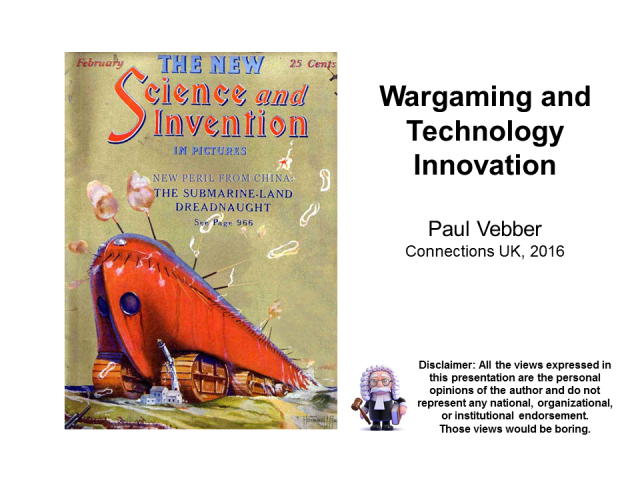
Connections UK was a tremendous experience this year. Being part of one of the panels was particularly enjoyable. Thanks to Graham Longley-Brown and Dr. Stephen Downes-Martin for including me as a presenter and panel member! I guess it pays to know gentleman with hyphenated names in the UK! Dr. Downes-Martin’s panel discussed “Wargaming and Innovation”. Sharing the stage with a pair of phenomenal young women, Ellie Bartles and Laura Hoffman, demonstrated that professional wargaming will be in good hands long after grey-haired gents like me retire!
Using wargaming to facilitate technology innovation is one of my primary focus areas in my role as lead of the Naval Sea Systems Command Warfare Center’s Fleet Engagement Community of Practice Wargaming Line of Effort and Asst. Director for Concept Development and Wargaming in the Office of the Mission Area Director, Undersea Warfare (or as I joked given the ponderousness of all that, simply “The Wargame Dork”).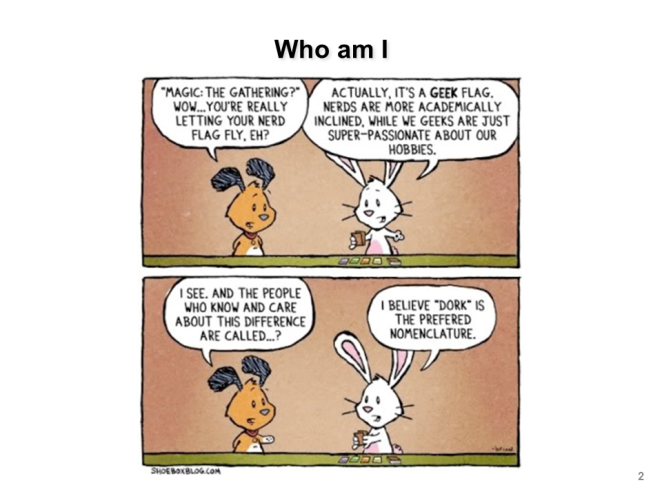
The audio of the talk is up on the Connections UK website, but for those who don’t want to spend 20 minutes listening to the dulcet tones of my voice, what follows is a review and extension. I opened my talk reinforcing my mantra that to be a “game savvy” engineer, scientist or analyst, or a serious game designer, you MUST PLAY GAMES!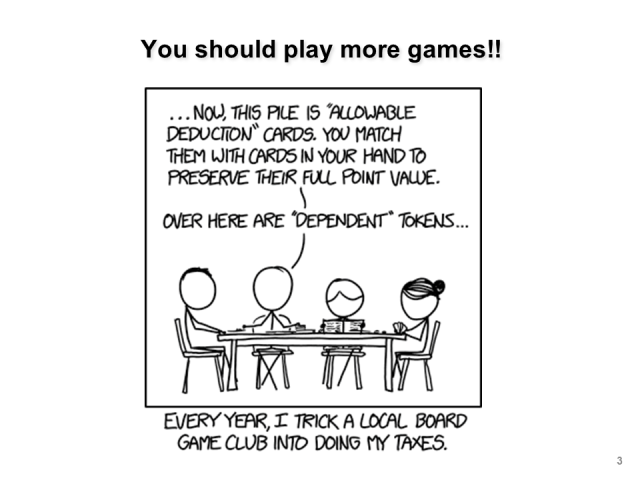 All types of games. Euro-style games, hex and counter wargames, matrix-style games, role-playing games (RPG), real-time sims (RTS) and first person shooters (FPS). Manual games and computer games. Even to be a professional player of “serious games” the more gameplay you engage in, the greater the range of game types you can contribute to, and the wider range of game-play experience you can leverage. Despite this being pretty obvious to gamers, its surprising how hard it is to create a professional work environment where members of the workforce feel “permitted to play”. Interminable “lean, six-sigma” meetings, “hack-a-thons” and “slack-a-thons” and “yellow-sticky innovation cells” are encouraged. Try to replace one of those demonstrably less effective techniques with a game-based event and the demands for “proof of ROI” echo down the hallways.A “Game-play champion” as high as possible in the organization (as I have been empowered to do in my organization) is required and even then takes a while. Adding “Gamepaly elements” to the aforementioned types of events is something I’ve found effective in waging a “gaming insurgency”.
All types of games. Euro-style games, hex and counter wargames, matrix-style games, role-playing games (RPG), real-time sims (RTS) and first person shooters (FPS). Manual games and computer games. Even to be a professional player of “serious games” the more gameplay you engage in, the greater the range of game types you can contribute to, and the wider range of game-play experience you can leverage. Despite this being pretty obvious to gamers, its surprising how hard it is to create a professional work environment where members of the workforce feel “permitted to play”. Interminable “lean, six-sigma” meetings, “hack-a-thons” and “slack-a-thons” and “yellow-sticky innovation cells” are encouraged. Try to replace one of those demonstrably less effective techniques with a game-based event and the demands for “proof of ROI” echo down the hallways.A “Game-play champion” as high as possible in the organization (as I have been empowered to do in my organization) is required and even then takes a while. Adding “Gamepaly elements” to the aforementioned types of events is something I’ve found effective in waging a “gaming insurgency”.
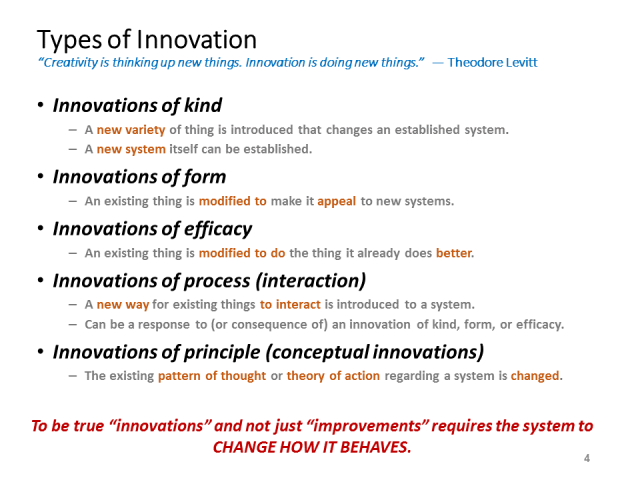 The meat of my presentation is about Innovation, Technology and Wargaming and the relationship between them as “ends”, “ways” and “means”. I opened with some discussion of what those terms mean to me. I’m a big fan of Everett Rodger’s book “Diffusion of Innovations” in which he makes a point of the centrality of changes in behavior to innovation. I thought the typology presented above from from the book, but searching my Kindle for it, I could not find it. If anyone knows the source, please let me know! Categorizing innovations in terms of the effect on the system(s) they are a part of struck me as more informative than typical “business-oriented” descriptions of innovation (which in many cases is synonymous with “creativity”.
The meat of my presentation is about Innovation, Technology and Wargaming and the relationship between them as “ends”, “ways” and “means”. I opened with some discussion of what those terms mean to me. I’m a big fan of Everett Rodger’s book “Diffusion of Innovations” in which he makes a point of the centrality of changes in behavior to innovation. I thought the typology presented above from from the book, but searching my Kindle for it, I could not find it. If anyone knows the source, please let me know! Categorizing innovations in terms of the effect on the system(s) they are a part of struck me as more informative than typical “business-oriented” descriptions of innovation (which in many cases is synonymous with “creativity”.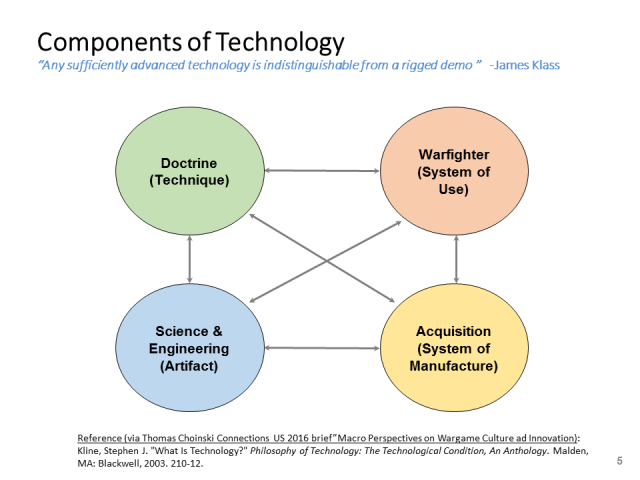
My co-worker Tom Choinski, in work he has done in his Ph.D. dissertation research placed Stephen Kline’s decomposition of the components of “technology” in the context of military application. Since that is the framework I approach the issue of technology innovation from, I like the manner in which it emphasizes that technology is an interactive activity, not a “gizmo”. The artifact is important but is only one piece of the technology puzzle. We tend to think of change in behavior of the “system” in terms of “what happens to the other parts of technology when you introduce a better (or different) artifact?”. Typical brain-storming techniques applied to technology innovation tend to approach the problem from that point of view. Either “how do I make my new gizmo achieve one or more of those types of innovation” or “In order to change my system, what kind of new gizmo do I want”. Gaming helps explore the wider scope all four components above combined incorporate.

Given the nature of the Connections UK audience, I hid the above slide to make more time for the process slides below, but given the arguments that break out at every wagaming community event about “what’s a wargame”. I often include them for information about “where I’m coming from” when I use the different terms. Despite being ambiguously lumped together in the defense community as “M&S”, I make an important distinction between models and simulations regarding time. Models are time invariate – they always give the same answer. Simulations change over time as they are frameworks to determine the interaction between models over time. I consider a “game” to be humans using simulations to achieve goals. This is often “cooperative” as players work together. Its not a “wargame” (I often use “kriegspiel” for clarity vs the various uses of wargame and war game and simulation game) unless there is competition – somebody “wins”. MOre specifically a game that uses a map of other graphic representation of the landscape upon which the competition occurs, some kind of pieces that represent the tools the players use to compete with each other (may be tokens, cards, or other means) and an agreed upon methodology to determine the outcomes of players actions (free or rigid forms). Now the importance of which side wins depends on the objectives, but the centrality of competition between multiple, interacting sides to achieve objectives is to me what makes a game a “kriegspiel”. The other important thing to a kriegspiel is the “level of abstraction” or how closely coupled the simulations upon which the game are based to reality. More on this a couple of slides down.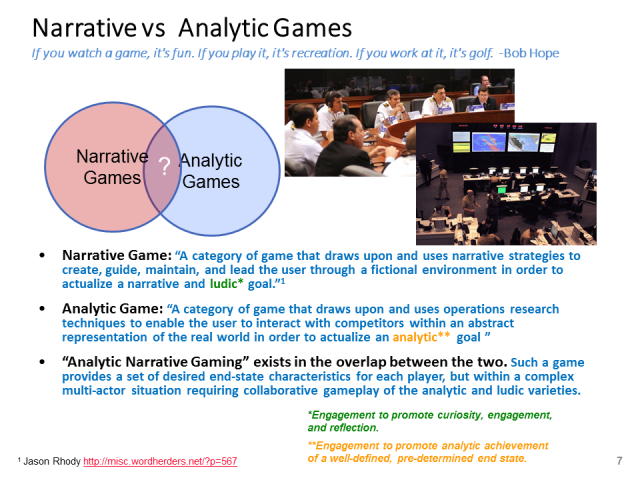
While I hid this slide as well, I find it useful to categorize games depending on the type of interaction the players have with each other, the white cell, and control cell toward what sort of goal. Note that there can be a distinction in my mind between a “white cell” – whose job it is to mange information and communication between the players and “the rest of the world” – and the control cell which deals with adjudication of events and collecting data about player decision-making. I find Jason Rhody’s distinction between ludic and analytic goals useful in this regard. I adapted his definitions a bit in the green and yellow notes in the slide above. In my experience facilitating technology innovation, that its the games that “promote curiosity, engagement and reflection” that are more useful – particularly early in the process – than those that are highly structured to “promote analytic achievement of a well-defined, predetermined end-state”. Note that the “end-state” here is the end-state of the game event from the point of view of “why we are playing the game” not the player point of vie of “objective to be attained through game-play”.
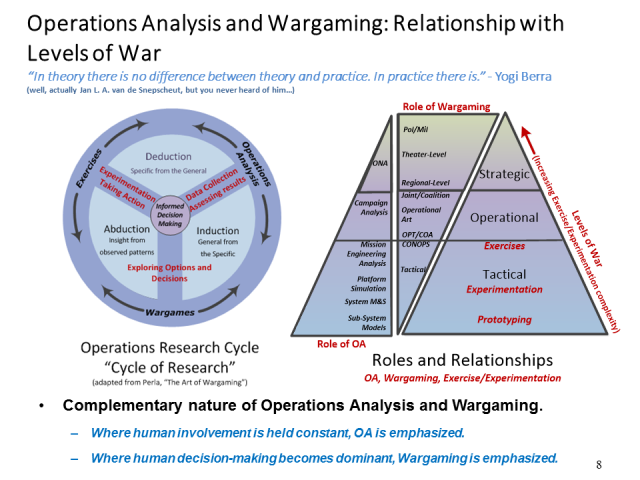
The final introductory slide adapts Peter Perla’s “Cycle of Research” diagram adding what I believe the predominate type of reasoning is to move from one spoke to another of the cycle. This will be important in the next slide where I discuss the types of wargames and how the relate to the process I propose. I also differentiate “operations analysis” from “operations research” which encompasses all the techniques represented in the cycle of which operations analysis is one. Exercises and experimentation produce broad categories of data that can be analyzed deductively to produce specific relationships that can be explored via operations analysis techniques, and vice versa. These specific relationships are used as part of wargame design and execution to create (or adjust in future iterations) the framework in which the game design is grounded. Game execution involves “that other” form of reasoning – abduction (or as C.S. Peirce later called it “Retroduction”) – whereby new insights and hypotheses are conceived of based on patterns observed and reflected upon during gameplay. It can also floe the other way where exercises and experimentation provides the specific data that can be used in a similar way.
The the other diagram is one of my own creation to illustrate the relationship between wargaming, operations analysis and exercises/experimentation and the “levels of war”. The levels affect exercises as regards their complexity. Tactical exercises can be conducted within the lifelines of a single platform, or at the high operational or even strategic level, events like RIMPAC involve months of preparation, weeks of execution and objectives that border reach beyond the military into the diplomatic realm. Of more interest to the topic of the presentation is the “twin triangles” representing the degree to which wargaming or operations analysis is leveraged to complete the cycle of research at a given level of war. At the lowest levels, in the context of my work represented by the performance of subsystem models of system components, these are fundamentally engineering problems with little input of human decision-makers. The realm of strategic “pol-mil” problem solving is almost entirely determined by humans making decisions – something notoriously difficult to analyze. Its my experience that the high tactical/low operational level is where the partnership between wargaming and operations analysis is the most complementary. I characterize this area by the need to consider the capabilities of the individual weapons systems on the platforms represented in the context of all the “military functions” (personnel and training, intelligence operations, fires, maneuver, logistics, planning, communications, and force protection). At lower levels, fewer humans are involved in the decision-making and the context of those decisions are more easily represented through abstractions about training and education in TTP and doctrine. At the higher operational and strategic levels, the specific platform capabilities can be generalized or aggregated focusing only on those aspects relevant to the decision-making context. In that middle ground, finding the right abstraction level that doesn’t over-complicate capability representation, or hand-wave at the complexities representing the interaction between military functions.
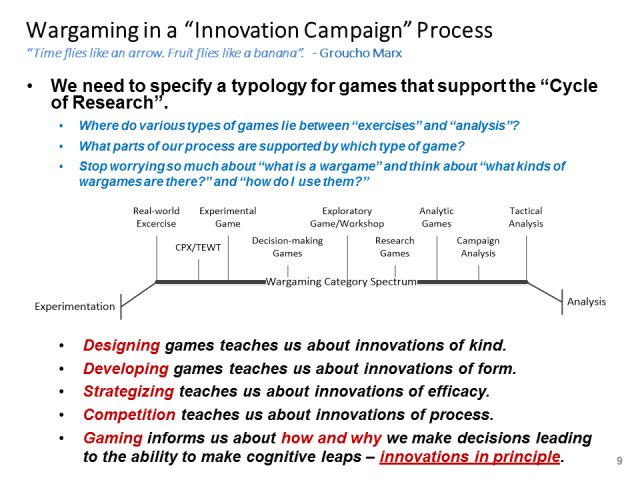
I’ll finish this introduction with my attempt to “zoom in” on the wargaming portion of the cycle and what I have found to be a useful arrangement of types of games between the “exercise” end and the “operations analysis end”. I also indicate what I see the relationship between gaming related activities and the types of innovation. I will readily attempt to mixing “gaming” and “wargaming” in the slides and in my explanation. I think from a technical innovation standpoint narrative cooperative games can be in many ways more useful than kriegspiels. I have three slides I hid during the Connections talk that provide more detail on each type and will use those to start part II of this discussion.

Conquering New Frontiers: Wargaming and the Innovation of Technology. Dive into the World of Strategy and Tech